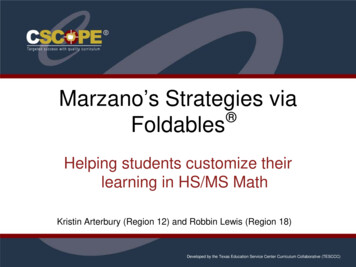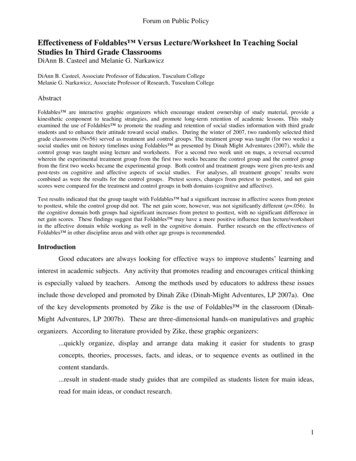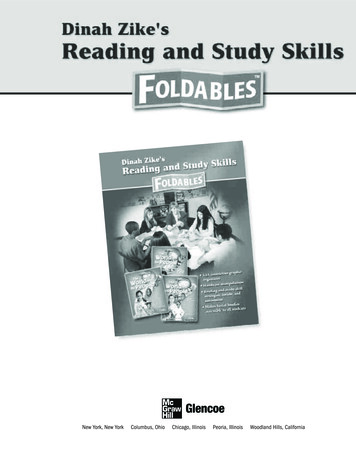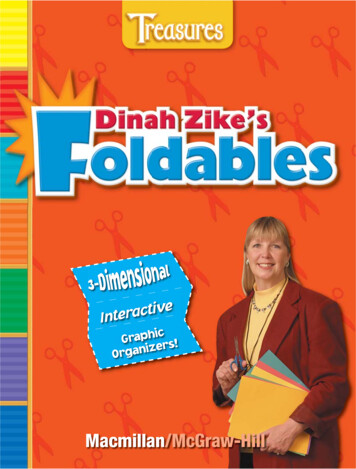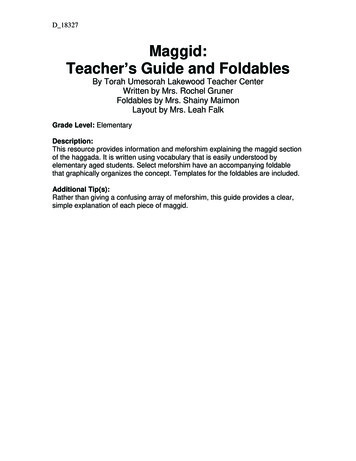
Transcription
Research to Support Foldables in the ClassroomBy Rhonda Meyer, Ph.D. and Nancy Wisker, M.A.Graphic organizers are powerful learning tools. Most of us are especially familiar withgraphic organizers such as diagrams, maps, outlines, and charts, all of which are two dimensional. Foldables are three-dimensional, interactive graphic organizers that werecreated more than 30 years ago by educator Dinah Zike. Foldables “encourage studentownership of study material, provide a kinesthetic component to teaching strategies,and promote long-term retention of academic lessons” (Casteel & Narkawicz, 2006, p.6).Based on current research, graphic organizers are extremely useful teaching andlearning tools. Graphic organizers are visual representations combining line, shape,space and symbols to convey facts and concepts or to organize information. Graphicorganizers, when designed and used appropriately: Speed up communication Help organize information Are easy-to-understand Show complex relationships Clarify concepts with few words Convey ideas and understandingGraphic organizers help students organize information in a visual manner. The oldsaying that “a picture is worth a thousand words” gets a new twist when applied tographic organizers. This is a profound concept, especially as the number of non-nativeEnglish-speaking students increases. A student is able to utilize graphic organizers toclarify concepts or to convey ideas and understandings with fewer words.Graphic organizers also make complex relationships or concepts easier to understand,especially for visual learners. Foldables take that process to the next level, especiallyfor tactile/kinesthetic learners. For example, once students have made a “three-tabFoldable” they will never forget there are (insert appropriate subject area example: forSocial Studies: three branches of the government; for Science: three types of rock; forMath: three measures of central tendency; for generic elementary: three primary colors).When to use graphic organizersGraphic organizers may be used at any point during instruction, but just as with anyother instructional strategy, they are most successful when they are built into theinstructional plan, rather than presented as an ‘extra’ activity.Graphic organizers can be used to supplement note-taking and outlining. Many studentsdo not know how to,take classroom notes. They often write profusely, attempting tocatch every word, but sometimes missing key words or concepts along the way.Graphic organizers, including concept maps, tables, and tree diagrams, may work betterDinah Zike Academy; do not reproduce without permission 2011Page 1
than outline notes in helping students discover relationships between concepts(Robinson & Kiewra, 1995). Foldables help teach students how to take notes by visuallyand kinesthetically chunking information into sections and providing limited space fornote-taking. Some studies indicate that it may be more valuable to learn to analyzeinformation and to select only the important points rather than writing verbatim notes(Bretzing & Kulhavy, 1979; Van Meter, et al., 1994).Graphic organizers are often used to reinforce understanding, or to review information.Students use them to organize ideas or to show relationships between concepts.Foldables may be used as an alternative form of assessment in the classroom. Becausethe Foldable has readily identifiable sections, a teacher can quickly see gaps in studentknowledge!Reading and Writing Across the CurriculumGraphic organizers have been shown to be highly effective in literacy development. Innumerous studies, graphic organizers help improve the development of literacy skills—including oral, written, and comprehension. In one study, researchers concluded thatgraphic organizers helped at least 80 percent of students master key vocabulary skills(Brookbank et.al,. 1999). Other studies found that elementary students’ writing skillsimproved when graphic organizers were part of the writing process (Gallick-Jackson,1997; Meyer,1995). Reading comprehension was found to have improved with youngstudents when graphic organizers were used (Brookbank, et.al., 1999; Sinatra, et.al.,1984).The National Reading Panel (2000) found that graphic and semantic organizers are oneof the seven most effective categories of instruction to improve reading comprehension.Graphic organizers aid students in developing critical thinking and other higher-orderthinking skills (Brookbank, et.al., 1999; DeWispelaere & Kossack, 1996) Other studiesfound that graphic organizers are a helpful tool for improving retention and recall ofinformation for students at all ages and skill levels (Bos & Anders, 1992; Ritchie & Volkl,2000; Griffin, et.al., 1995).ScienceGraphic organizers have been shown to aid student comprehension and retention ofscience material (Guastello, et.al., 2000; Hawk, 1986; Ritchie & Voklk, 2000; Simmons,et.al., 1988; Willerman & Mac Harg, 1991). In the science classroom, we try to helpstudents organize their thoughts. Scientists classify, categorize, and organize things, soFoldables are a perfect fit—with Foldables, we put information in chunks that makesense.Social StudiesGraphic organizers have been found to help students organize information fromexpository social studies texts and comprehend content area reading. They also helpstudents select, organize, and recall relevant information and help transfer thinking andlearning skills to new situations and content areas (Alvermann & Boothby, 1983;Dinah Zike Academy; do not reproduce without permission 2011Page 2
Alverman & Boothby, 1986; Armbruster, et.al., 1991; Griffin, et.al., 1995). Casteel &Narkawicz (2006) compared lecture/worksheet style instruction with instruction focusedaround the use of Foldables in a social studies classroom and found that Foldablessignificantly improved students’ attitudes toward the discipline.MathematicsIn mathematics, graphic organizers may help students develop stronger problemsolving skills as well as general mathematical skills and knowledge (Braselton &Decker, 1994; Monroe & Orme, 2002).Students with Special NeedsGraphic organizers may help English language learners improve higher-order thinkingskills (DeWispelaere & Kossack, 1996).Because of their visual organization, graphic organizers seem to be quite beneficial foruse with learning disabled students. They appear to help students comprehend contentarea material, to organize information, and to retain and recall content (Boyle &Weishaar, 1997; Doyle, 1999; Gardill & Jitendra, 1999; Griffin et al., 1991; Scanlon etal., 1992; Sinatra et.al., 1984).ConclusionsThere is a common thread to the research cited here: graphic organizers may lead toimproved student performance, whether measured by classroom-based observation,textbook assessments, or standardized assessments, when compared with moretraditional forms of instruction.Graphic organizers work at all grade levels. They seem to be just as effective withprimary students as with high school or college students. Studies have been conductedwith early elementary (Brookbank et al., 1999), upper elementary/intermediate grades,and middle school (Guastello et al., 2000), and with secondary grades/high school(Doyle, 1999), all showing similar results.There are four keys or phases to effective learning, according to Kolb (1984). Thesephases are: getting involved through concrete experience, reflective listening andobservation, creating an idea with an abstract conceptualization, and making decisionsthrough active experimentation. Graphic organizers address all four of these phases atsome level and, when combined with other classroom instruction, they can be apowerful tool for learning.Marzano, Pickering, and Pollack (2001) contend that to foster higher-order thinking,instruction must require learners to restructure prior knowledge and to link it to newinformation. These researchers and others use graphic organizers to restructureexisting knowledge and make new connections.When students construct their own graphic organizers, as they do with Foldables, theyare active participants in their learning (Moore and Readence, 1984). StudentDinah Zike Academy; do not reproduce without permission 2011Page 3
constructed graphic organizers allow teachers to observe levels of understanding, toidentify misconceptions, and to make appropriate instructional interventions (Naughton,1993, 1994).Our goal as educators is to help students glean important information and understandkey concepts and to be able to relate these concepts or apply them to real-worldsituations.There is clear and consistent support for the effectiveness of graphic organizers.Students read textbooks, magazines and newspaper articles, trade books, and websites to gain information to answer questions. Reading is intentional thinking duringwhich the reader constructs meaning from the text. Graphic organizers help support anddevelop students’ note-taking skills, summarizing skills, reading comprehension, andvocabulary development which leads to better understanding and application of contentarea topics.Dinah Zike Academy; do not reproduce without permission 2011Page 4
ReferencesSome of these research citations are annotated to focus on the most relevant elementsof the research to elementary and middle school students and teachers.Anders, P.L., Bos C.S., and Filip, D. (1984). The effect of semantic feature analysis onthe reading comprehension of learning disabled students. In J.A. Niles and L.A. Harris(Eds.), changing Perspectives on Reading/Language processing and Instruction (pp.162-166). Rochester, N.Y.: The National Reading Conference.Adger, C.T. (1995) Engaging students: thinking, talking, cooperating. Thousand Oaks,CA: Corwin Press.Alvermann, D.E. & Boothby, P.R. (1983). A preliminary investigation of the differencesin children's retention of "inconsiderate" text. Reading Psychology: An InternationalQuarterly, 4, 237-246.Alvermann, D.E. & Boothby, P.R. (1986). Children's transfer of graphic organizerinstruction. Reading Psychology: An International Quarterly, 7(2), 87-100.Anders, P.L., Bos, C.S., & Filip, D. (1984). The effect of semantic feature analysis onthe reading comprehension of learning disabled students. In J.A. Niles and L.A. Harris(Eds.), Changing Perspectives on Reading/Language Processing and Instruction (pp.162-166). Rochester, NY: The National Reading Conference.Armbruster, B.B., Anderson, T.H., Armstrong, J.O., Wise, M.A., Janisch, C., & Meyer,L.A. (1991). Reading and questioning in content area lessons. Journal of ReadingBehavior, 23, 35-60.Bos, C.N. & Anders, P.L. (1992). Using interactive teaching and learning strategies topromote text comprehension and content learning for students with learning disabilities.International Journal of Disability, Development, and Education, 39, 225-238.Boyle, J.R. & Weishaar, M. (1997). The effects of expert-generated versus studentgenerated cognitive organizers on the reading comprehension of students with learningdisabilities. Learning Disabilities Research & Practice, 12(4), 228-235.Braselton, S. & Decker, B.C. (1994). Using graphic organizers to improve the reading ofmathematics. The Reading Teacher, 48(3), 276-282.Bretzing, B.H., & Kulhavy, R.W. (1979) Note-taking and depth of processing.Contemporary Educational Psychology, 4, 145-153.Brookbank, D., Grover, S., Kullberg, K., & Strawser, C. (1999). Improving studentachievement through organization of student learning. Chicago: Master's ActionResearch Project, Saint Xavier University and IRI/Skylight. (ERIC DocumentReproduction Service No. ED435094).Dinah Zike Academy; do not reproduce without permission 2011Page 5
Carter, J.F. & Van Matre, N.H. (1975). Note taking versus note having. Journal ofEducational Psychology, 67(6), 900-904.Casteel, D.B., Narkawicz, M.G. (2006). “Effectiveness of Foldables VersusLecture/Worksheet In Teaching Social Studies in Third Grade Classrooms”. Efficacystudy. The Forum on Public Policy.Chi, M. (985). Interactive roles of knowledge and strategies in the development oforganized sorting and recall. In S.F. Chipman, J.W. Segal, & R. Glaser (Eds.), thinkingand learning skills, Vol.2: Research and open questions. Hillsdale, NJ: LawrenceErlbaum Associates.The author reviews research with children and adults demonstrating that “categoryclustering” (grouping items based on perceived similarities) leads to greater recall, andthat children as young as 3 years old have some ability to use clusters to aid recall. Theresearch studies presented here, working with children ages 4-8, demonstrate that themore one’s knowledge is organized into schemas, or organized frameworks, the easierit is to remember and extend that knowledge.IDansereau, D.F. (1985). Learning strategy research. In J.W. Segal, S F Chipman, &R. Glaser (Eds.), Thinking and learning skills, Vol. 1: Relating instruction to research.Hillsdale, NU: Lawrence Erlbaum Associates.DeWispelaere, C. & Kossack, J. (1996). Improving student higher order thinking skillsthrough the use of graphic organizers. Elk Grove Village, IL: Master’s Thesis, SaintXavier University.Doyle, C.S. (1999). The use of graphic organizers to improve comprehension oflearning disabled students in social studies. Union, NJ: Master of Arts Research Project,Kean University.Dye, G.A. (2000). Graphic organizers to the rescue! Helping students link—andremember—information. Teaching Exceptional Children, 32 (3), 72-76.Egan, M. (1999). Reflections on ffective us of graphic organizers. Journal of Adolescent& Adult literacy, 42 (8), 641-645.Ekhami, L. (1998). Graphic organizers: Outlets for your thoughts. School Library MediaActivities Monthly, 14 (5), 29-33.Fisher, D., Zike, D., and Frey, N. (2007). Foldables: Improving Learning with 3-DInteractive Graphic Organizers. Classroom Notes Plus, August 2007, Urbana, IL:National Council of Teachers of EnglishDinah Zike Academy; do not reproduce without permission 2011Page 6
Gallego, M.A., Duran, G.Z., & Scanlon, D.J. (1989). Interactive teaching and learning:Facilitating learning disabled students' transition from novice to expert. Literacy Theoryand Research, 311-319.Gallick-Jackson, S.A. (1997). Improving narrative writing skills, composition skills, andrelated attitudes among second grade students by integrating word processing, graphicorganizers, and art into a process approach to writing. Fort Lauderdale, FL: Master ofScience Practicum Project, Nova Southeastern University.Gardill, M.C. & Jitendra, A.K. (1999). Advanced story map instruction: Effects on thereading comprehension of students with learning disabilities. The Journal of SpecialEducation, 33, 2-17.Griffin, C., Malone, L., & Kameenui, E.J. (1995). Effects of graphic organizer instructionon fifth-grade students. Journal of Educational Research, 89(2), 98-107.Griffin, C., Simmons, D.C., & Kameenui, E.J. (1991). Investigating the effectiveness ofgraphic organizer instruction on the comprehension and recall of science content bystudents with learning disabilities. Journal of Reading, Writing, and Learning DisabilitiesInternational, 7, 355-376.Guastello, E.F., Beasley, T.M., & Sinatra, R.C. (2000). Concept mapping effects onscience content comprehension of low-achieving inner-city seventh graders. Remedialand Special Education, 21, 356-364.Hagan-Heimlich, J.E. and Pittelman, S.D. (1984). Classroom Applications of theSemantic Mapping Procedure in Reading and Writing. (Program Report 84-4).This report reviews the theory and research relevant to semantic mapping and givesexamples of classroom applications.Hawk, P.P. (1986). Using graphic organizers to increase achievement in middle schoollife science. Science Education, 70, 81-87.Irwin-Devitis, L. and pearse, D. (1995). Using graphic organizers for learning andassessment in middle level classrooms. Middle School Journal, 26 (5), 57-64.Jones, B.F., Amiran, M., and Katims, M. (1985). Teaching cognitive strategies and textstructures within language arts programs. In J.W. Segal, S.F. Chipman, and R. Glaser(Eds.). thinking and learning Skills, Vol. 1: Relating instruction to research. Hillsdale, NJ:Lawrence Erlbaum Asociates.In studies using college students and seventh-grade students, those who had receivedtraining in “matrix outlining and analysis” (a form of graphic organizer) outperformedcontrol subjects in both recall of unordered information about a topic of instruction andessay writing on that topic.Kolb, D.A. (1984). Experiential Learning. Englewood Cliffs, NJ: Prentice Hall.Dinah Zike Academy; do not reproduce without permission 2011Page 7
Full statement and discussion of Kolb's ideas concerning experiential learning. Chaptersdeal with the foundation of contemporary approaches to experiential learning; theprocess of experiential learning; structural foundations of the learning process;individuality in learning and the concept of learning styles; the structure of knowledge;the experiential learning theory of development; learning and development in highereducation; lifelong learning and integrative development. http://www.infed.org/biblio/bexplrn.htmMarzano, R.J., Pickering, D.J., and Pollack, J.E. (2001). Classroom instruction thatworks. Alexandria, VA; ASCD Publications.This study focuses on nine essential strategies that have proven successful in contentarea K-12 classrooms. “Cues, Questions and Advance Organizers” is the labeldescribing the ninth successful strategy and the work describes how graphic organizers,presented prior to instruction, makes a difference with students comprehension andretention of content.McTighe, J. (1992). Graphic organizers: Collaborative links to better thinking. In N.Davidson and T. Worsham (Eds.), Embracing thinking through cooperative learning (pp.182-197). New York: Teachers College Press.Meyer, D.J. (1995). The effects of graphic organizers on the creative writing of thirdgrade students. Union, NJ: Master of Art Project, Kean College of New Jersey, 46 pp.Monroe, E.E., & Orme, M.P. (2002). Developing mathematical vocabulary. PreventingSchool Failure, 46(3), 139-142.Moore, D. & Readence, J. (1984). A quantitative and qualitative review of graphicorganizer research. Journal of Educational Research, 78, 11-17.National Institute of Child Health and Human Development. (2000). Report of theNational Reading Panel. Teaching children to read: An evidence-based assessment ofthe scientific research literature on reading and its implications for reading instruction(NIH Publication No. 00-4769). Washington, DC: US Government Printing Office.Naughton, V.M. (1993-94). Creative mapping for content reading. Journal of Reading,37, 324-326.Project Better. Website: School Improvement in Maryland Project.Articles on the power of successful teaching and learning using graphicorganizers such as Foldables.Ritchie, D. & Volkl, C. (2000). Effectiveness of two generative learning strategies in thescience classroom. School Science & Mathematics, 100, 83-89.Dinah Zike Academy; do not reproduce without permission 2011Page 8
Robinson, D.H., Kiewra, K.A. (1995). Visual argument: Graphic organizers are superiorto outlines in improving learning from text. Journal of Educational Psychology, 87(3),455-467.Scanlon, D.J., Duran, G.Z., Reyes, E.I., & Gallego, M.A. (1992). Interactive semanticmapping: An interactive approach to enhancing LD students' content areacomprehension. Learning Disabilities Research and Practice, 7, 142-146.Simmons, D.C., Griffin, C.C., & Kameenui, E.J. (1988). Effectiveness of teacherconstructed pre- and post-graphic organizer instruction on sixth-grade science students’comprehension and recall. Journal of Educational Research, 82, 15-21.Sinatra, R.C., Stahl-Glemake, J. & Berg, D.N. (1984). Improving reading comprehensionof disabled readers through semantic mapping. Reading Teacher 38, 22-29.Van Meter, P.M., Yokoi, L., Pressley, M. (1994). College students’ theory ofnote-taking derived from their perceptions of note-taking. Journal ofEducational Psychology, 86(3), 323-338Willerman, M. & MacHarg, R.A. (1991). The concept map as an advance organizer.Journal of Research in Science Teaching, 28(8), 705-712Additional information the use of Foldables and Graphic Organizers can be found at the following sites.Accessed ticles/mi qa3673/is n4 v118/ai n28707733/?tag tmhttp://www.verticylearning.org/docs/Verticy Results WhitePaper.pdfhttp://www.ifets.info/journals/10 1/17.pdfhttp://www.indiana.edu/ citation.cfm?id s/graphic organizer white paper 07-08.pdfDinah Zike Academy; do not reproduce without permission 2011Page 9
Research to Support Foldables in the Classroom . By Rhonda Meyer, Ph.D. and Nancy Wisker, M.A. Graphic organizers are powerful learning tools. Most of us are especially familiar with graphic organizers such as diagrams, maps, outlines, and charts, all of which are two-dimensional. Foldables
